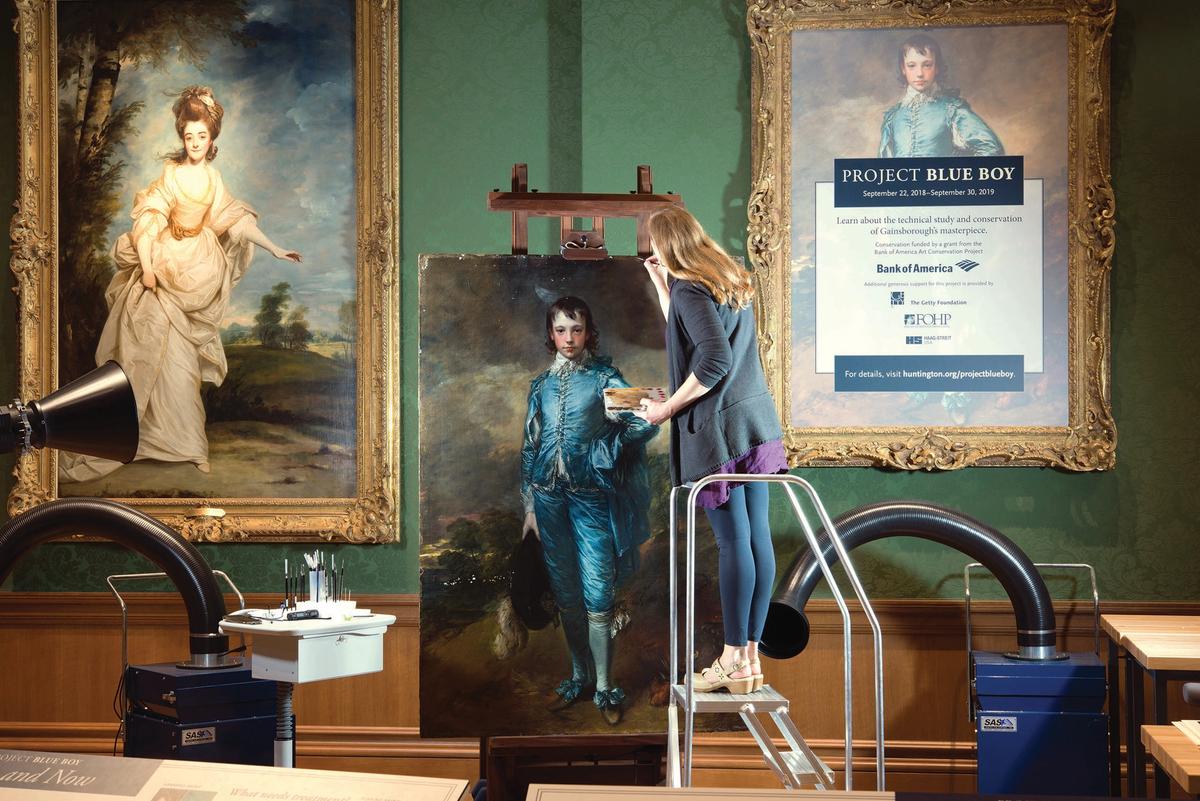After months in the conservation lab at the Huntington Library, Art Museum and Botanical Gardens, in San Marino, California, Thomas Gainsborough’s The Blue Boy (around 1770) is ready to go back on display, although the galleries are closed because of the coronavirus (Covid-19) pandemic until at least 15 May. In the meantime, the museum has posted a video about the restoration on its website.
The project began in 2013, when Christina O’Connell arrived at the Huntington as the institution’s first ever paintings conservator. She undertook a full survey of the museum’s art collection, examining around 600 paintings to assess their physical condition. The Huntington’s most famous grouping is in the stately Thornton Portrait Gallery, where full-length portraits in the British “grand manner” style are hung, including The Blue Boy, depicting a confident young man in a blue satin suit posing in the British countryside. In 1921 the American railroad mogul Henry Huntington bought the painting from the dealer Joseph Duveen for $728,800, the Huntington says; other reports from the period put the price at $640,000.
The painting needed considerable work, given its flaking paint, darkened varnishes and structural weaknesses
In 2017, O’Connell and Melinda McCurdy, the associate curator for British art, closely studied the work using the latest technologies, including infrared reflectography and multiple high-resolution X-rays that were digitally stitched together. “We spent a lot of time studying the materials and the technique of the artist, how they’ve aged over time,” says O’Connell, “and also understanding the history of past interventions, what’s been added”. The painting needed considerable work, given its flaking paint, darkened varnishes and structural weaknesses.
One surprise was an early 11-inch tear in the lower left side of the canvas, which was revealed through the X-rays. It had been well mended: the canvas fibres had been lined up and an overall protective backing was added. “My theory is that the tear happened sometime in the early 19th century,” McCurdy says. “It was exhibited several times, and I think it happened during shipping.”
Fortunately, says O’Connell, the tear was so well mended that she did not need to repair it again, but she did have to remove some earlier overpainting to reveal Gainsborough’s brushwork. Today, the tear is only noticeable if you stand to one side and catch the light just so—it appears as a slightly raised ridge.
After drawing up a plan of attack, O’Connell spent a year and a half working on The Blue Boy, including 12 months in public in the Thornton gallery, where she sat in a mini-lab behind a small exhibition that attracted more than 217,000 visitors. It was a way to keep the very popular painting on display while also teaching visitors about the conservation process. While O’Connell would regularly give talks to the public, most of the time she was working on the canvas while listening to podcasts on her headphones.
O’Connell started the conservation work by gluing down flaking paint, using tiny sable brushes and a surgical microscope. Then she undertook a thorough cleaning, using custom-made cotton swabs dipped in solvents. Slowly, she uncovered a brighter blue in the subject’s outfit—thought to be a costume for a ball—and details in the landscape on the lower left side that had darkened over the years. Last autumn The Blue Boy was brought into her lab for the finishing touches, which included mending smaller tears in the canvas, tacking edges and repairing cracks and splits in the wooden stretcher.
Apart from the canvas, O’Connell has also been working on the painting’s ornate gilt frame, which was not the one in which it was delivered to Huntington but dates from the same 18th-century period. “We’re adjusting the fit within the frame,” says O’Connell. “And we’re applying materials that make it safe for these fragile edges [of the canvas] to be in contact with the edges of the frame.” To separate the two, a barrier film is being added.
O’Connell says she is pleased with how the conservation has gone, remarking that few visitors will notice what she has done. “I’ve done my job when it’s invisible,” she says.


